中国贫困状况英文
传统中国贫困原因英文作文
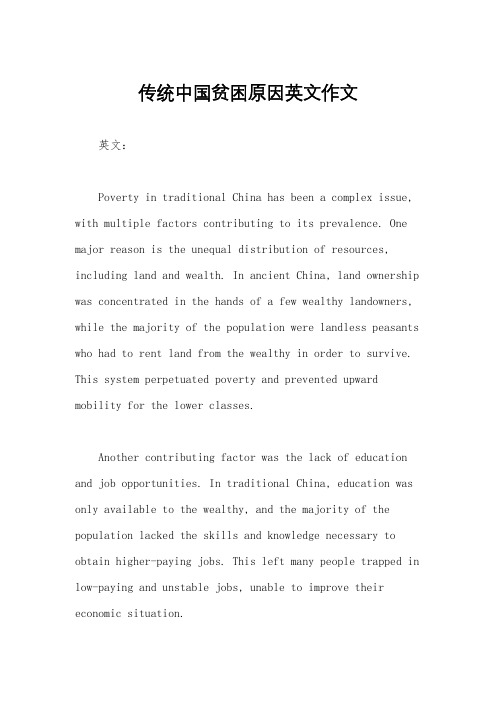
传统中国贫困原因英文作文英文:Poverty in traditional China has been a complex issue, with multiple factors contributing to its prevalence. One major reason is the unequal distribution of resources, including land and wealth. In ancient China, land ownership was concentrated in the hands of a few wealthy landowners, while the majority of the population were landless peasants who had to rent land from the wealthy in order to survive. This system perpetuated poverty and prevented upward mobility for the lower classes.Another contributing factor was the lack of education and job opportunities. In traditional China, education was only available to the wealthy, and the majority of the population lacked the skills and knowledge necessary to obtain higher-paying jobs. This left many people trapped in low-paying and unstable jobs, unable to improve their economic situation.Additionally, natural disasters such as floods, droughts, and famine were common in traditional China, and these events often pushed already impoverished families further into poverty. Without access to government aid or insurance, these families were forced to rely on their own resources to survive, which often led to debt and destitution.Overall, poverty in traditional China was a result of a combination of factors, including unequal distribution of resources, lack of education and job opportunities, and natural disasters.中文:传统中国的贫困问题是一个复杂的问题,有多种因素导致了贫困的普遍存在。
中国贫困作文英文
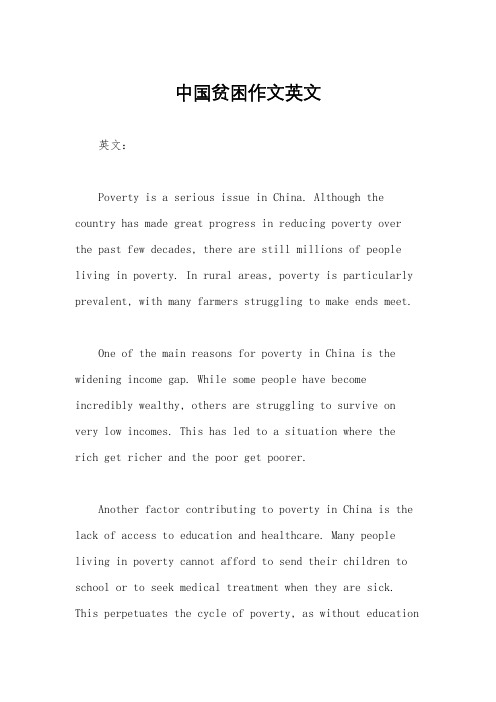
中国贫困作文英文英文:Poverty is a serious issue in China. Although the country has made great progress in reducing poverty over the past few decades, there are still millions of people living in poverty. In rural areas, poverty is particularly prevalent, with many farmers struggling to make ends meet.One of the main reasons for poverty in China is the widening income gap. While some people have become incredibly wealthy, others are struggling to survive on very low incomes. This has led to a situation where therich get richer and the poor get poorer.Another factor contributing to poverty in China is the lack of access to education and healthcare. Many people living in poverty cannot afford to send their children to school or to seek medical treatment when they are sick. This perpetuates the cycle of poverty, as without educationand healthcare, it is difficult for people to improve their economic situation.中文:贫困是中国的一个严重问题。
世界贫困现状英文作文初中

世界贫困现状英文作文初中英文回答:Poverty is a complex and multifaceted issue thataffects millions of people around the world. It is characterized by a lack of basic necessities, such as food, water, shelter, education, and healthcare. The World Bank defines extreme poverty as living on less than $1.90 per day.There are many factors that contribute to poverty, including inequality, discrimination, conflict, and environmental degradation. Poverty can also be perpetuated by a lack of access to education, healthcare, and other essential services.The impact of poverty is devastating. It can lead to malnutrition, disease, and death. It can also result in social isolation, discrimination, and violence. Poverty can also have a negative impact on children's development andtheir ability to reach their full potential.There are many different ways to address poverty. Some of the most effective strategies include:Promoting economic growth。
中国贫困状况英语作文高中

中国贫困状况英语作文高中英文:As a high school student, I am deeply concerned about the poverty situation in China. Poverty is a complex and multifaceted issue that affects millions of people in China. There are many factors that contribute to poverty,including lack of education, limited access to healthcare, and unequal distribution of resources.One of the biggest challenges in addressing poverty in China is the rural-urban divide. Many rural areas in China lack basic infrastructure and access to education and healthcare, which perpetuates the cycle of poverty. In contrast, urban areas have better access to resources and opportunities, leading to a stark contrast in living standards between the two regions.Another contributing factor to poverty in China is the lack of job opportunities, particularly for those withlimited education or skills. This leads to a high unemployment rate in many rural and urban areas, making it difficult for people to escape the cycle of poverty.In addition, the issue of poverty is exacerbated by the widening income gap in China. While some people enjoy great wealth and prosperity, there are still millions of people living in extreme poverty, struggling to make ends meet.中文:作为一名高中生,我对中国的贫困状况深感关注。
中国贫困原因 英文作文

中国贫困原因英文作文Poverty in China is caused by a variety of factors. One of the main reasons is the uneven distribution of wealth, with the rich getting richer and the poor getting poorer. This creates a cycle of poverty that is difficult to break.Another reason for poverty in China is the lack of access to education and healthcare. Many people in rural areas do not have the same opportunities for education and healthcare as those in urban areas, which perpetuates the cycle of poverty.Additionally, rapid urbanization has led to a large population of migrant workers who often struggle to find stable employment and adequate housing. This has contributed to the growing wealth gap and increased poverty in China.Furthermore, environmental degradation and natural disasters have also played a role in exacerbating povertyin China. Climate change, pollution, and deforestation have affected the livelihoods of many people, particularly those in rural areas who rely on agriculture for their income.Moreover, government policies and corruption have also contributed to the persistence of poverty in China. In some cases, local officials have embezzled funds meant for poverty alleviation, leaving those in need without the support they require.In conclusion, poverty in China is a complex issue with multiple contributing factors. Addressing this issue will require a comprehensive approach that tackles wealth inequality, improves access to education and healthcare, creates more opportunities for stable employment, and addresses environmental concerns.。
中国的贫困成就英语作文
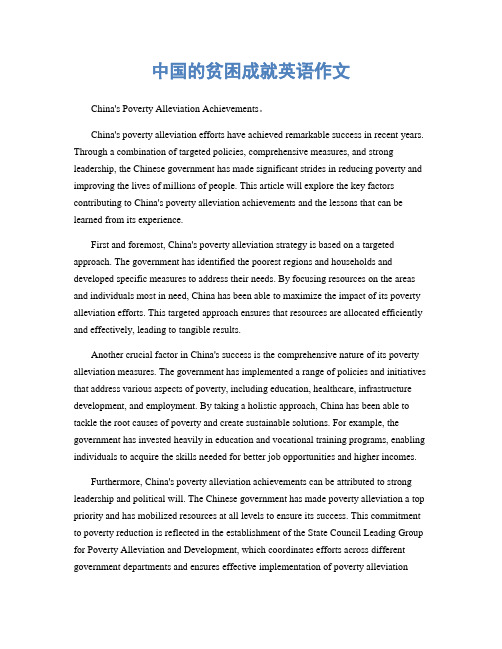
中国的贫困成就英语作文China's Poverty Alleviation Achievements。
China's poverty alleviation efforts have achieved remarkable success in recent years. Through a combination of targeted policies, comprehensive measures, and strong leadership, the Chinese government has made significant strides in reducing poverty and improving the lives of millions of people. This article will explore the key factors contributing to China's poverty alleviation achievements and the lessons that can be learned from its experience.First and foremost, China's poverty alleviation strategy is based on a targeted approach. The government has identified the poorest regions and households and developed specific measures to address their needs. By focusing resources on the areas and individuals most in need, China has been able to maximize the impact of its poverty alleviation efforts. This targeted approach ensures that resources are allocated efficiently and effectively, leading to tangible results.Another crucial factor in China's success is the comprehensive nature of its poverty alleviation measures. The government has implemented a range of policies and initiatives that address various aspects of poverty, including education, healthcare, infrastructure development, and employment. By taking a holistic approach, China has been able to tackle the root causes of poverty and create sustainable solutions. For example, the government has invested heavily in education and vocational training programs, enabling individuals to acquire the skills needed for better job opportunities and higher incomes.Furthermore, China's poverty alleviation achievements can be attributed to strong leadership and political will. The Chinese government has made poverty alleviation a top priority and has mobilized resources at all levels to ensure its success. This commitment to poverty reduction is reflected in the establishment of the State Council Leading Group for Poverty Alleviation and Development, which coordinates efforts across different government departments and ensures effective implementation of poverty alleviationpolicies. The strong leadership and political will demonstrated by the Chinese government have been instrumental in driving forward the poverty alleviation agenda.China's poverty alleviation achievements also highlight the importance of international cooperation and collaboration. The Chinese government has actively engaged with international organizations, such as the United Nations and the World Bank, to share its experiences and learn from other countries' best practices. By leveraging global knowledge and expertise, China has been able to enhance the effectiveness of its poverty alleviation efforts. This international collaboration has not only benefited China but has also contributed to the global fight against poverty.In conclusion, China's poverty alleviation achievements are a testament to the effectiveness of targeted policies, comprehensive measures, strong leadership, and international cooperation. By adopting a targeted approach, addressing multiple dimensions of poverty, and mobilizing resources at all levels, China has made significant progress in reducing poverty and improving the lives of its people. The success of China's poverty alleviation efforts provides valuable lessons for other countries facing similar challenges. It underscores the importance of a comprehensive and targeted approach, as well as the need for strong leadership and political will. As China continues its poverty alleviation journey, it serves as an inspiration and a role model for the rest of the world.。
中国扶贫的英文作文素材

中国扶贫的英文作文素材Title: China's Poverty Alleviation Efforts: A Comprehensive Overview。
In recent decades, China has made remarkable strides in alleviating poverty, a complex and multifaceted issue that has long plagued the nation. Through a combination ofpolicy initiatives, targeted interventions, and socioeconomic development strategies, China has effectively lifted millions out of poverty, garnering global attention and admiration. This essay aims to delve into the key components of China's poverty alleviation efforts, highlighting the approaches, challenges, and outcomes.To begin with, China's poverty alleviation strategy is characterized by its comprehensive and multifaceted approach. The government has implemented a range ofpolicies and programs aimed at addressing various dimensions of poverty, including income poverty, education poverty, healthcare poverty, and rural poverty. Theseinitiatives encompass targeted poverty alleviation measures, infrastructure development projects, social welfare programs, and efforts to promote sustainable economicgrowth in impoverished regions.One of the cornerstones of China's poverty alleviation efforts is the targeted approach, which involvesidentifying and assisting impoverished individuals and households through precise and data-driven methods. This approach relies on accurate poverty mapping, household surveys, and the establishment of poverty alleviation databases to ensure that resources are allocatedeffectively and reach those in need. By tailoring interventions to specific circumstances and requirements, China can maximize the impact of its poverty alleviation initiatives and facilitate sustainable outcomes.Moreover, China's poverty alleviation strategy emphasizes the importance of education and human capital development as key drivers of poverty reduction. The government has implemented various measures to improve access to education, enhance the quality of schooling inrural areas, and promote vocational training and skills development among impoverished populations. By investing in education and empowering individuals with the knowledge and skills necessary to participate in the modern economy, China aims to break the cycle of intergenerational poverty and foster long-term socioeconomic development.Additionally, China has prioritized healthcare as a fundamental aspect of its poverty alleviation efforts, recognizing that access to healthcare services and medical insurance is essential for improving living standards and reducing vulnerability to economic shocks. The government has implemented initiatives such as the New Rural Cooperative Medical Scheme (NRCMS) and the Basic Medical Insurance Scheme (BMI) to expand healthcare coverage and provide financial assistance to impoverished individuals facing medical expenses. Furthermore, China has invested in the construction of healthcare facilities, the training of medical personnel, and the deployment of mobile healthcare services in remote and underserved areas to ensure equitable access to healthcare for all citizens.Furthermore, China's poverty alleviation efforts are closely linked to its broader agenda of ruralrevitalization and inclusive development. The governmenthas prioritized the development of rural areas, which are disproportionately affected by poverty, through initiatives such as the "Rural Revitalization Strategy" and the "Three Rural Issues" campaign. These initiatives aim to modernize agriculture, improve rural infrastructure, promote rural industries, and enhance social services in rural communities, thereby creating employment opportunities, stimulating economic growth, and improving living standards for rural residents.Despite the significant progress made, China faces various challenges in its ongoing poverty alleviation efforts. Persistent regional disparities, limited access to resources and infrastructure in remote areas, environmental degradation, and the impact of global economic fluctuations are among the key challenges that must be addressed to ensure sustainable and inclusive development. Moreover, as China transitions from alleviating absolute poverty to addressing relative poverty and promoting shared prosperity,it must adopt more targeted and nuanced approaches tailored to the diverse needs and circumstances of different regions and population groups.In conclusion, China's poverty alleviation efforts represent a remarkable example of proactive governance, innovative policy-making, and concerted action to address one of the most pressing challenges facing the nation. Through its comprehensive and targeted approach, China has achieved significant progress in reducing poverty, improving living standards, and enhancing social inclusion. However, sustained efforts and continued investment will be required to consolidate these gains, address remaining challenges, and achieve the goal of building a moderately prosperous society in all respects.Overall word count: 805。
中国扶贫英文作文

中国扶贫英文作文China's poverty alleviation efforts have made significant progress in recent years. The government has implemented a series of targeted measures to help lift people out of poverty, such as providing financial support, vocational training, and access to basic healthcare services.Many poverty alleviation projects in China focus on rural areas, where the majority of the country's poor population resides. These projects aim to improve infrastructure, promote agricultural development, and provide education and healthcare services to those in need.In addition to government efforts, non-governmental organizations and volunteers also play a crucial role in poverty alleviation in China. They provide support and assistance to vulnerable groups, such as the elderly, disabled, and orphaned children, helping them improve their living conditions and access to education and healthcare.China's poverty alleviation efforts have also been recognized internationally. The country has shared its experiences and best practices with other developing countries, contributing to global poverty reduction efforts and sustainable development.Despite the progress made, challenges still exist in China's poverty alleviation work. Some remote and underdeveloped areas still face difficulties in accessing basic resources and services, and more efforts are needed to ensure that no one is left behind in the country's development.Overall, China's poverty alleviation efforts have achieved remarkable results, lifting millions of people out of poverty and improving their quality of life. Thecountry's commitment to eradicating poverty and promoting sustainable development serves as a valuable example for the rest of the world.。
中国消除贫困的英文作文
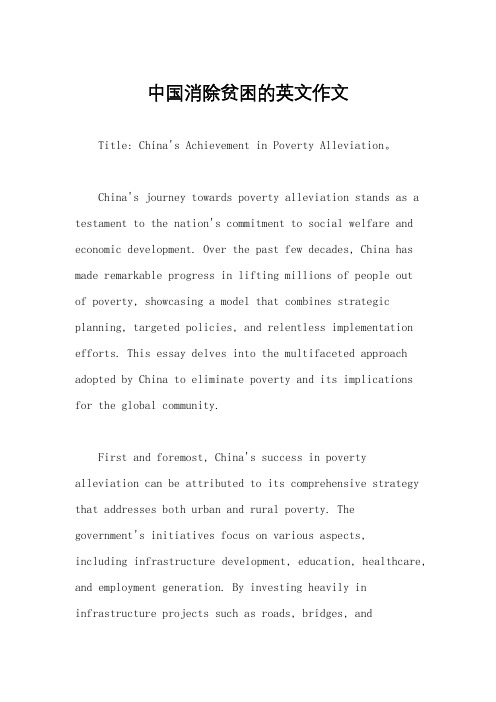
中国消除贫困的英文作文Title: China's Achievement in Poverty Alleviation。
China's journey towards poverty alleviation stands as a testament to the nation's commitment to social welfare and economic development. Over the past few decades, China has made remarkable progress in lifting millions of people outof poverty, showcasing a model that combines strategic planning, targeted policies, and relentless implementation efforts. This essay delves into the multifaceted approach adopted by China to eliminate poverty and its implications for the global community.First and foremost, China's success in povertyalleviation can be attributed to its comprehensive strategy that addresses both urban and rural poverty. Thegovernment's initiatives focus on various aspects,including infrastructure development, education, healthcare, and employment generation. By investing heavily in infrastructure projects such as roads, bridges, andtelecommunications networks, China has connected remote areas to urban centers, facilitating the flow of goods, services, and opportunities.Moreover, China's emphasis on education has played a pivotal role in breaking the cycle of poverty. The government has implemented policies to ensure access to education for all, including subsidies for school fees, textbooks, and uniforms. Additionally, vocational training programs have equipped individuals with the skills needed to secure stable employment in emerging industries, further boosting socioeconomic mobility.Furthermore, China's healthcare reforms have improved access to essential medical services for marginalized communities. The establishment of rural health clinics and the expansion of health insurance coverage have reduced the financial burden of healthcare expenses on low-income households. As a result, fewer people are pushed into poverty due to catastrophic health expenditures, contributing to overall poverty reduction.In addition to these domestic efforts, China has also leveraged international cooperation to support its poverty alleviation endeavors. Through initiatives such as the Belt and Road Initiative (BRI) and South-South cooperation, China has extended financial assistance, technological expertise, and capacity-building support to developing countries facing similar challenges. By sharing its experiences and best practices, China has contributed to the global fight against poverty and promoted sustainable development worldwide.The significance of China's achievement in poverty alleviation extends beyond its borders. As the world's most populous country, China's success demonstrates the feasibility of lifting millions out of poverty within a relatively short span of time. By showcasing a model of economic growth that prioritizes social welfare and inclusive development, China has inspired other nations to adopt similar approaches tailored to their unique contexts.However, despite its remarkable progress, China continues to face challenges in ensuring equitabledevelopment and addressing pockets of persistent poverty. Disparities between urban and rural areas, as well as among different regions, remain a concern. Additionally, environmental degradation and natural disasters posethreats to the livelihoods of vulnerable communities, necessitating sustained efforts to build resilience and promote sustainable development.In conclusion, China's achievement in povertyalleviation stands as a remarkable feat with profound implications for global development. Through its comprehensive approach, China has demonstrated the effectiveness of strategic planning, targeted policies, and international cooperation in combating poverty andpromoting inclusive growth. As China continues on its path towards building a moderately prosperous society, its experiences offer valuable lessons for the international community in the pursuit of a more just and equitable world.。
关于我国扶贫的英语作文高中
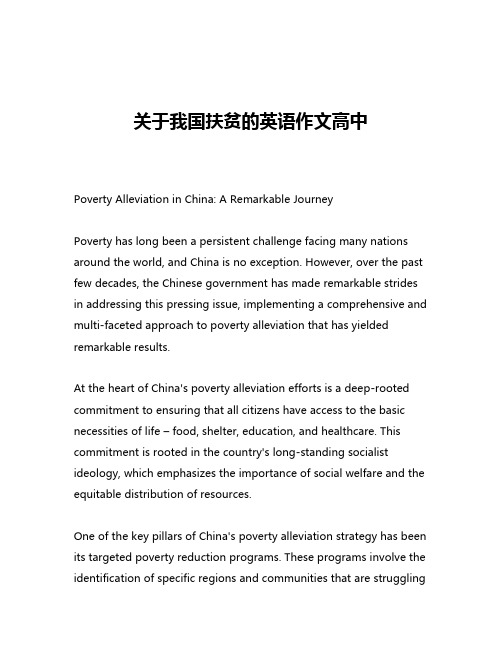
关于我国扶贫的英语作文高中Poverty Alleviation in China: A Remarkable JourneyPoverty has long been a persistent challenge facing many nations around the world, and China is no exception. However, over the past few decades, the Chinese government has made remarkable strides in addressing this pressing issue, implementing a comprehensive and multi-faceted approach to poverty alleviation that has yielded remarkable results.At the heart of China's poverty alleviation efforts is a deep-rooted commitment to ensuring that all citizens have access to the basic necessities of life – food, shelter, education, and healthcare. This commitment is rooted in the country's long-standing socialist ideology, which emphasizes the importance of social welfare and the equitable distribution of resources.One of the key pillars of China's poverty alleviation strategy has been its targeted poverty reduction programs. These programs involve the identification of specific regions and communities that are strugglingwith poverty, and the implementation of tailored interventions to address their unique needs. This might include the provision of financial assistance, the development of infrastructure, the promotion of entrepreneurship and job creation, or the improvement of access to essential services such as healthcare and education.A prime example of this targeted approach is the Poverty Alleviation Relocation Program, which has been instrumental in lifting millions of people out of poverty. Under this program, the government has identified impoverished communities living in remote or geographically challenging areas and has provided them with the resources and support necessary to relocate to more prosperous regions. This not only improves their access to essential services but also opens up new economic opportunities, helping to break the cycle of poverty.Another key aspect of China's poverty alleviation efforts is its emphasis on sustainable development. Rather than simply providing short-term handouts, the government has focused on empowering communities to become self-reliant and resilient. This has involved investing in the development of local industries, promoting the use of renewable energy, and fostering the growth of small and medium-sized enterprises.One success story in this regard is the development of eco-tourismin some of China's most impoverished regions. By leveraging the natural beauty and cultural heritage of these areas, the government has been able to create new economic opportunities for local residents, while also promoting environmental protection and sustainable resource management.The results of these efforts have been truly remarkable. Since the launch of its targeted poverty alleviation programs in 2015, China has lifted more than 90 million people out of poverty, reducing the country's poverty rate from 10.2% to just 0.6% by the end of 2020. This achievement is all the more impressive when one considers the scale and complexity of the challenge, with China being home to the world's largest population and a diverse array of geographic and socio-economic conditions.However, the success of China's poverty alleviation efforts extends beyond just the numbers. The government's approach has also had a profound impact on the lives of individual citizens, empowering them to take control of their own destinies and build a brighter future for themselves and their families.One such example is the story of Li Jianhua, a farmer from a remote village in Guizhou Province. Like many of his neighbors, Li struggled with poverty for years, relying on subsistence farming and occasional odd jobs to make ends meet. But when the government's povertyalleviation programs arrived in his village, Li was able to access the resources and support he needed to start a small poultry farm.With the help of government subsidies and technical training, Li was able to grow his business and increase his income significantly. Today, he is not only able to provide for his own family, but he has also become a role model for other villagers, inspiring them to follow in his footsteps and take advantage of the opportunities available to them.Stories like Li's are not uncommon across China, and they serve as a testament to the transformative power of the government's poverty alleviation efforts. By empowering individuals and communities to take control of their own destinies, these programs have not only lifted millions out of poverty but have also fostered a sense of hope and optimism for the future.Of course, the fight against poverty is far from over, and there are still many challenges that China must overcome. The COVID-19 pandemic, for example, has posed a significant setback, threatening to undo some of the hard-won progress that has been made in recent years.However, the Chinese government remains steadfast in its commitment to eradicating poverty and ensuring that all of itscitizens have access to the resources and opportunities they need to thrive. With its innovative and comprehensive approach to poverty alleviation, China has set an inspiring example for the rest of the world, demonstrating that with the right strategies and the unwavering determination of its people, even the most daunting challenges can be overcome.。
关于中国贫困状况英文作文
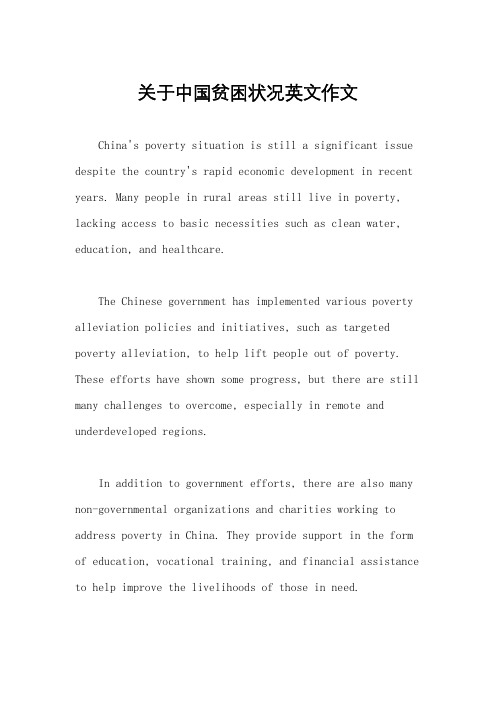
关于中国贫困状况英文作文China's poverty situation is still a significant issue despite the country's rapid economic development in recent years. Many people in rural areas still live in poverty, lacking access to basic necessities such as clean water, education, and healthcare.The Chinese government has implemented various poverty alleviation policies and initiatives, such as targeted poverty alleviation, to help lift people out of poverty. These efforts have shown some progress, but there are still many challenges to overcome, especially in remote and underdeveloped regions.In addition to government efforts, there are also many non-governmental organizations and charities working to address poverty in China. They provide support in the form of education, vocational training, and financial assistance to help improve the livelihoods of those in need.One of the root causes of poverty in China is the widening income gap between urban and rural areas. Many rural residents have limited access to job opportunities and face lower wages compared to their urban counterparts, making it difficult for them to escape poverty.Another factor contributing to the persistence of poverty in China is the lack of social welfare systems in place to support vulnerable populations. This includes the elderly, people with disabilities, and those living in remote areas, who often struggle to access essential services and support.Despite these challenges, there is hope for the future as China continues to prioritize poverty alleviation as a key policy goal. With continued efforts from both the government and civil society, there is potential to make significant progress in reducing poverty and improving the lives of millions of people in China.。
人口贫困英文作文
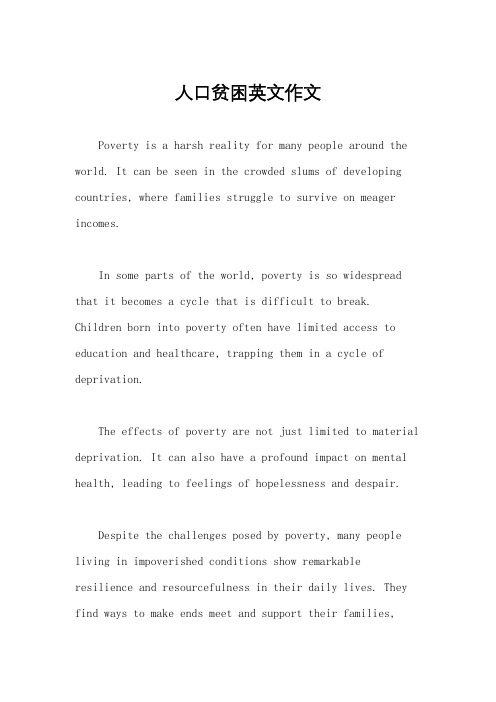
人口贫困英文作文Poverty is a harsh reality for many people around the world. It can be seen in the crowded slums of developing countries, where families struggle to survive on meager incomes.In some parts of the world, poverty is so widespread that it becomes a cycle that is difficult to break. Children born into poverty often have limited access to education and healthcare, trapping them in a cycle of deprivation.The effects of poverty are not just limited to material deprivation. It can also have a profound impact on mental health, leading to feelings of hopelessness and despair.Despite the challenges posed by poverty, many people living in impoverished conditions show remarkableresilience and resourcefulness in their daily lives. They find ways to make ends meet and support their families,even in the face of overwhelming odds.Addressing poverty requires a multi-faceted approach that involves not only providing material assistance, but also addressing the underlying social and economic factors that contribute to inequality. Only by addressing these root causes can we hope to create a more just and equitable society for all.。
中国贫困状况英文作文初中
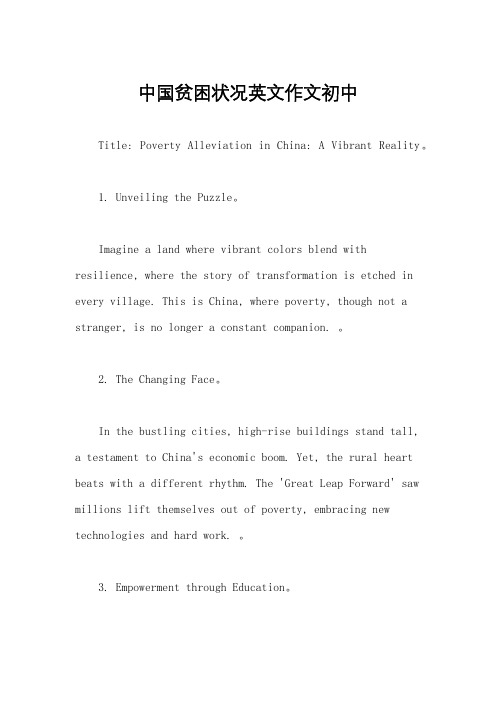
中国贫困状况英文作文初中Title: Poverty Alleviation in China: A Vibrant Reality。
1. Unveiling the Puzzle。
Imagine a land where vibrant colors blend with resilience, where the story of transformation is etched in every village. This is China, where poverty, though not a stranger, is no longer a constant companion. 。
2. The Changing Face。
In the bustling cities, high-rise buildings stand tall, a testament to China's economic boom. Yet, the rural heart beats with a different rhythm. The 'Great Leap Forward' saw millions lift themselves out of poverty, embracing new technologies and hard work. 。
3. Empowerment through Education。
Education, the catalyst, has been the secret weapon. Every child, regardless of background, gets a chance to break the cycle. Literacy rates soar, opening doors to better job opportunities. 。
中国贫困状况英文作文高中
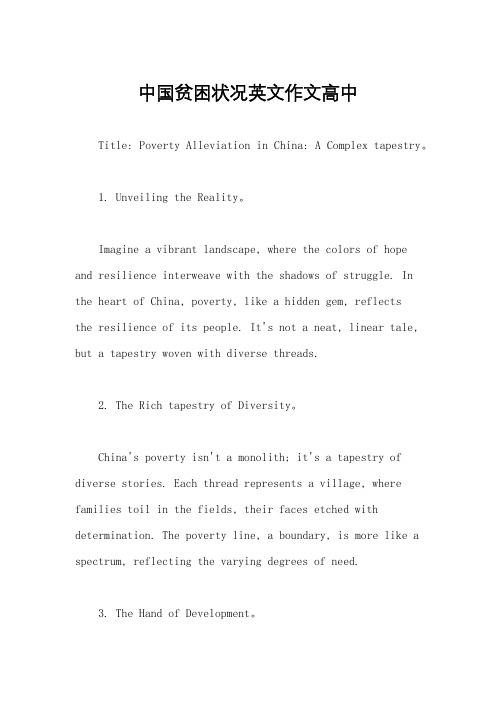
中国贫困状况英文作文高中Title: Poverty Alleviation in China: A Complex tapestry。
1. Unveiling the Reality。
Imagine a vibrant landscape, where the colors of hope and resilience interweave with the shadows of struggle. In the heart of China, poverty, like a hidden gem, reflectsthe resilience of its people. It's not a neat, linear tale, but a tapestry woven with diverse threads.2. The Rich tapestry of Diversity。
China's poverty isn't a monolith; it's a tapestry of diverse stories. Each thread represents a village, where families toil in the fields, their faces etched with determination. The poverty line, a boundary, is more like a spectrum, reflecting the varying degrees of need.3. The Hand of Development。
The Chinese government, like a skilled weaver, has been at the forefront of this transformation. Policies like the Poverty Eradication Strategy are the guiding threads, weaving a path towards economic growth. It's not just about numbers, but about lifting people out of poverty, one village at a time.4. The Threads of Education。
关于我国扶贫的英语作文高中
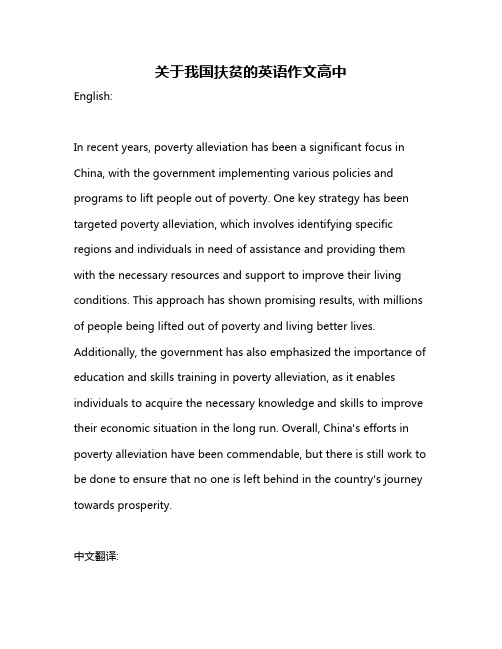
关于我国扶贫的英语作文高中English:In recent years, poverty alleviation has been a significant focus in China, with the government implementing various policies and programs to lift people out of poverty. One key strategy has been targeted poverty alleviation, which involves identifying specific regions and individuals in need of assistance and providing them with the necessary resources and support to improve their living conditions. This approach has shown promising results, with millions of people being lifted out of poverty and living better lives. Additionally, the government has also emphasized the importance of education and skills training in poverty alleviation, as it enables individuals to acquire the necessary knowledge and skills to improve their economic situation in the long run. Overall, China's efforts in poverty alleviation have been commendable, but there is still work to be done to ensure that no one is left behind in the country's journey towards prosperity.中文翻译:近年来,扶贫成为中国的一个重要关注点,政府实施了各种政策和项目来帮助人们摆脱贫困。
英文介绍中国扶贫情况作文
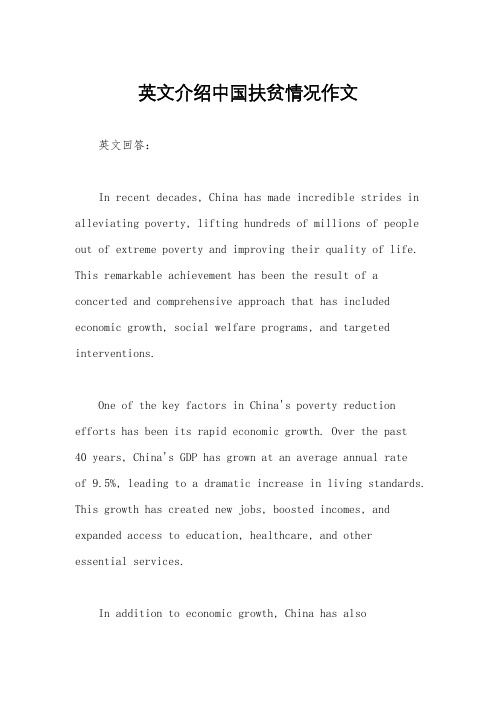
英文介绍中国扶贫情况作文英文回答:In recent decades, China has made incredible strides in alleviating poverty, lifting hundreds of millions of people out of extreme poverty and improving their quality of life. This remarkable achievement has been the result of a concerted and comprehensive approach that has included economic growth, social welfare programs, and targeted interventions.One of the key factors in China's poverty reduction efforts has been its rapid economic growth. Over the past40 years, China's GDP has grown at an average annual rateof 9.5%, leading to a dramatic increase in living standards. This growth has created new jobs, boosted incomes, and expanded access to education, healthcare, and otheressential services.In addition to economic growth, China has alsoimplemented a range of social welfare programs to support vulnerable populations. These programs include cash transfers, subsidized housing, and free healthcare for low-income families. These programs have been effective in reducing poverty and improving the well-being of the most disadvantaged members of society.Finally, China has also implemented targeted interventions to address the specific needs of impoverished communities. These interventions have includedinfrastructure projects, such as building roads and bridges, and providing access to clean water and sanitation. They have also included job training programs and micro-credit schemes to help people start their own businesses.As a result of these efforts, China has madesignificant progress in reducing poverty. In 2012, theWorld Bank estimated that the number of people living in extreme poverty in China had fallen to 10.7%, down from 88% in 1981. This represents a remarkable achievement and has significantly improved the lives of millions of people.中文回答:中国在最近几十年在扶贫方面取得了令人瞩目的成就,帮助数亿人脱贫致富,提高了他们的生活质量。
中国农村脱贫英语作文
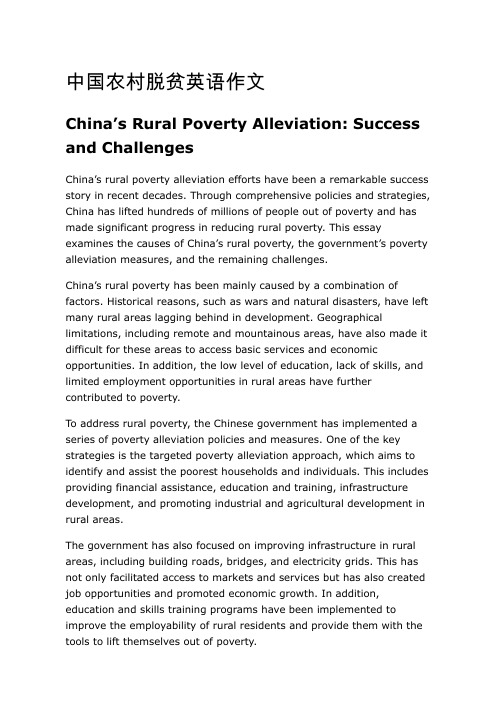
中国农村脱贫英语作文China’s Rural Poverty Alleviation: Success and ChallengesChina’s rural poverty alleviation efforts have been a remarkable success story in recent decades. Through comprehensive policies and strategies, China has lifted hundreds of millions of people out of poverty and has made significant progress in reducing rural poverty. This essay examines the causes of China’s rural poverty, the government’s poverty alleviation measures, and the remaining challenges.China’s rural poverty has been mainly caused by a combination of factors. Historical reasons, such as wars and natural disasters, have left many rural areas lagging behind in development. Geographical limitations, including remote and mountainous areas, have also made it difficult for these areas to access basic services and economic opportunities. In addition, the low level of education, lack of skills, and limited employment opportunities in rural areas have further contributed to poverty.To address rural poverty, the Chinese government has implemented a series of poverty alleviation policies and measures. One of the key strategies is the targeted poverty alleviation approach, which aims to identify and assist the poorest households and individuals. This includes providing financial assistance, education and training, infrastructure development, and promoting industrial and agricultural development in rural areas.The government has also focused on improving infrastructure in rural areas, including building roads, bridges, and electricity grids. This has not only facilitated access to markets and services but has also created job opportunities and promoted economic growth. In addition, education and skills training programs have been implemented to improve the employability of rural residents and provide them with the tools to lift themselves out of poverty.Another important aspect of China’s poverty alleviation efforts is the promotion of rural industry and agriculture. The government has supported the development of rural enterprises, cooperative organizations, and agricultural modernization, helping farmers increase their income and sustainable development. Moreover, the government has implemented poverty reduction relocation programs, moving disadvantaged populations from environmentally fragile areas to more developed regions, providing them with better living conditions and development opportunities.Through these efforts, China has achieved significant poverty reduction results. According to official data, China has lifted more than 800 million rural poor out of poverty, and the poverty rate in rural areas has dropped significantly. The living standards of rural residents have improved significantly, with access to better education, healthcare, and infrastructure.However, despite the great achievements, some challenges still remain in rural poverty alleviation. One of the challenges is to ensure the long-term stability and sustainability of poverty reduction. Some poverty reduction measures may have a short-term effect, but it is necessary to establish a long-term mechanism to prevent poverty from recurring. Moreover, there is a need to further address the issue of poverty among the remaining poor population, especially those in remote and vulnerable areas.Another challenge is to promote the comprehensive development of rural areas. Poverty alleviation is not only about increasing income but also about improving the overall development level of rural areas, including education, healthcare, cultural construction, and ecological environment. Balanced and sustainable rural development requires further attention and investment in these areas.China’s rural poverty alleviation efforts have achieved remarkable results, but more needs to be done to address the remaining challenges. Continuing to strengthen poverty reduction policies and measures, promoting sustainable development, and addressing the needs of the most vulnerable populations are crucial steps towards achieving the goal of rural revitalization and building a moderatelyprosperous society in an all-round way. China’s experience in rural poverty alleviation provides valuable insights and lessons for other countries in the world to learn from.。
中国农村脱贫英语作文高中
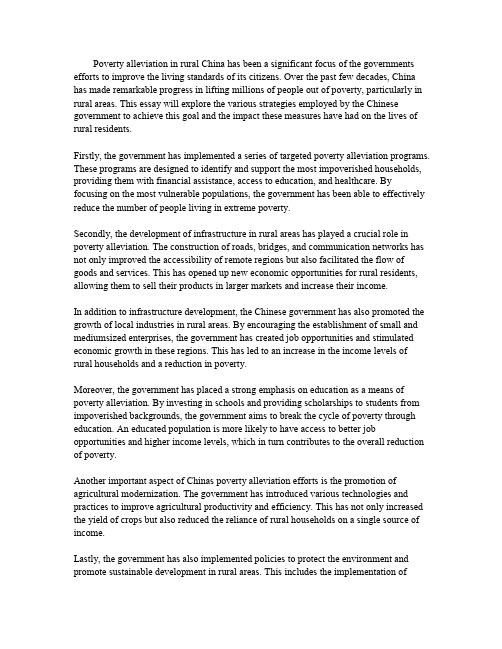
Poverty alleviation in rural China has been a significant focus of the governments efforts to improve the living standards of its citizens. Over the past few decades, China has made remarkable progress in lifting millions of people out of poverty, particularly in rural areas. This essay will explore the various strategies employed by the Chinese government to achieve this goal and the impact these measures have had on the lives of rural residents.Firstly, the government has implemented a series of targeted poverty alleviation programs. These programs are designed to identify and support the most impoverished households, providing them with financial assistance, access to education, and healthcare. By focusing on the most vulnerable populations, the government has been able to effectively reduce the number of people living in extreme poverty.Secondly, the development of infrastructure in rural areas has played a crucial role in poverty alleviation. The construction of roads, bridges, and communication networks has not only improved the accessibility of remote regions but also facilitated the flow of goods and services. This has opened up new economic opportunities for rural residents, allowing them to sell their products in larger markets and increase their income.In addition to infrastructure development, the Chinese government has also promoted the growth of local industries in rural areas. By encouraging the establishment of small and mediumsized enterprises, the government has created job opportunities and stimulated economic growth in these regions. This has led to an increase in the income levels of rural households and a reduction in poverty.Moreover, the government has placed a strong emphasis on education as a means of poverty alleviation. By investing in schools and providing scholarships to students from impoverished backgrounds, the government aims to break the cycle of poverty through education. An educated population is more likely to have access to better job opportunities and higher income levels, which in turn contributes to the overall reduction of poverty.Another important aspect of Chinas poverty alleviation efforts is the promotion of agricultural modernization. The government has introduced various technologies and practices to improve agricultural productivity and efficiency. This has not only increased the yield of crops but also reduced the reliance of rural households on a single source of income.Lastly, the government has also implemented policies to protect the environment and promote sustainable development in rural areas. This includes the implementation ofreforestation programs, water conservation measures, and the promotion of ecofriendly agricultural practices. By ensuring the longterm sustainability of rural economies, the government is not only addressing the immediate issue of poverty but also laying the foundation for a prosperous future.In conclusion, the Chinese governments multifaceted approach to poverty alleviation in rural areas has yielded significant results. Through targeted programs, infrastructure development, promotion of local industries, investment in education, agricultural modernization, and environmental protection, millions of rural residents have been lifted out of poverty. While challenges remain, the progress made thus far serves as a testament to the effectiveness of these strategies and offers hope for a future where poverty is eradicated in rural China.。
中国贫困作文英文

中国贫困作文英文Poverty is a major issue in China, affecting millions of people across the country. Despite China's rapid economic growth in recent years, poverty remains a persistent problem, particularly in rural areas.Many factors contribute to poverty in China. One major factor is the urban-rural divide, which creates significant disparities in income and access to resources. Rural areas often lack the infrastructure and investment needed to support economic growth, leaving many people without access to basic services like healthcare and education.Another factor is the lack of job opportunities inrural areas. Many people in rural areas are forced to rely on agriculture for their livelihoods, which can be unpredictable and vulnerable to natural disasters like droughts and floods. This makes it difficult for people to escape poverty and improve their standard of living.The Chinese government has implemented a number of policies and programs aimed at reducing poverty in the country. These include initiatives to increase access to education and healthcare, as well as programs to promote economic development in rural areas. However, progress has been slow, and poverty remains a significant challenge for many people in China.One potential solution to poverty in China is to focus on sustainable development. This means investing in infrastructure and resources that can support long-term economic growth, rather than relying on short-termsolutions like aid and charity. By promoting sustainable development, China can create more job opportunities and improve access to basic services, helping to lift people out of poverty and improve their quality of life.In conclusion, poverty is a major issue in China, particularly in rural areas. While the government has implemented a number of programs and policies aimed at reducing poverty, progress has been slow, and more needs to be done to address this challenge. By focusing onsustainable development and investing in infrastructure and resources, China can create a brighter future for millions of people across the country.。
- 1、下载文档前请自行甄别文档内容的完整性,平台不提供额外的编辑、内容补充、找答案等附加服务。
- 2、"仅部分预览"的文档,不可在线预览部分如存在完整性等问题,可反馈申请退款(可完整预览的文档不适用该条件!)。
- 3、如文档侵犯您的权益,请联系客服反馈,我们会尽快为您处理(人工客服工作时间:9:00-18:30)。
The general introduction of poverty problems in China Reasons Measures taken and to be taken
the general introduction
the period of planned economy
表1:中国城市贫困人口变化趋势
年份 1988 1995 1999 2002
贫困线(元/人年)
289
2107
2382
634——3840
贫困规模(百万人)
0.7
19.1
13.4
19.6
贫困发生率(%)
0.2
5.4
3.5
4.1
Reasons
the consequence of the structure caused by changed economy
B.调整产业结构,扩大就业领域和范围 发展第三产业尤其是社区服务业:零售业、不动产业、出 租业、家庭服务业、修理业、娱乐业、教育、医疗保健,等 等。 发展私营个体经济:未来吸纳就业的主要力量。 发展劳动密集型的中小企业。 开展国内跨区和国际跨国劳务流动和输出。 C.完善再就业服务体系 建立以劳动力市场需求为导向的职业技能培训体系,加大 再就业领域财政资源投入力度,创造保护性安置就业岗位, 完善法律法规体系。 To adjust the industrial structure, and expand employment field and scope The development of the third industry especially community service industry: retail, real estate industry, ChuZuYe, family service, repairing,
• those out of work and the unemployed again obtain employment, new employment labor employed • A re-employment project • 1993 to 30 cities carry out "the reemployment project" pilot • In 1998, the provisions of the tax burden reduction, capital credit, industry and commerce registration and the arrangement of laid-off workers to support and preferential. • Establish again obtain employment service center: looking for employment. • Widen again obtain employment domain and the development of jobs. • Carry out again obtain employment training and guidance services.
the period of co laid-off and unemployed workers have a large presence, different income groups differentiation of the growing gap between rich and poor enlarging trend gradually expansion, absolute poverty and relative poverty problem is getting worse.
4.2.1促进就业政策
(1)内容:下岗者和失业者再就业,新增就业劳动力就业 (2)措施: A.再就业工程 1993年30个城市开展“再就业工程”试点 1998年,规定资金信贷、税负减免、工商登记和场地安排等方面给下岗职工扶持和优惠。 建立再就业服务中心:寻找就业机会。 拓宽就业领域并开发再就业岗位。 开展再就业培训与指导服务。those out of work and the unemployed again obtain employment, new employment labor employed • A re-employment project • 1993 to 30 cities carry out "the reemployment project" pilot • In 1998, the provisions of the tax burden reduction, capital credit, industry and commerce registration and the arrangement of laid-off workers to support and preferential. • Establish again obtain employment service center: looking for employment. • Widen again obtain employment domain and the development of jobs. • Carry out again obtain employment training and guidance services.
4.2.1促进就业政策 下岗职工基本生活费制度 失业保险制度 城市居民最低生活保障制度 城镇职工基本医疗保险制度。 公共服务与社会救助 其它政策支持The off-duty workers basic living expenses system Unemployment insurance system System of safeguard of townsman lowest life Basic medical insurance system for urban employees. Public service and social assistance Other policy support
Life level close, income group differentiation is not significant, the gap between rich and poor is small, general life level is low. Enterprise provide social welfare and labor safeguard, residents between each other difference.
The first industry density lowered, agricultural labor pouring into the city, worsening the original the obtain employment of personnel of the urban employment environment, and created a new lowlowincome people.
inequality in income-distributionRegional
income gap: regional development imbalance, northwest and northeast, different reasons. At the same time, social basic life project cost growth too fast, lead to the burden of poverty population than rich people more huge burden.
the begnning of the reform
The development of the private economy gradually expand space, foreign capital to begin to enter Chinese, first time income distribution way began to change. Different income groups began to appear differentiation, poverty gap appeared, the overall level of living gap began pulling away。
lack of employment
not sound in the system of social security ◎Social security face narrow: people cannot all included in the scope of
protection. The state-owned units are the main object Foreign investment, private enterprise, private individual and industrial and commercial door, are not included in the floating population. Security level is low: social security project less, the system is not complete,and relief and difficult allowance standard is too low Social security of the low level of socialization, BaoZhangFei ShouJiaoLv is low, the enterprise defaults, misappropriate or unable to pay the security fees for outstanding phenomenon Social security funds sources single: national finance capacity weakness and enterprise, lower benefit, especially the local government financial resources is weak, the surplus and laid-off workers, numerous enterprises generally very low efficiency. Some social security project system reform existence of loopholes
